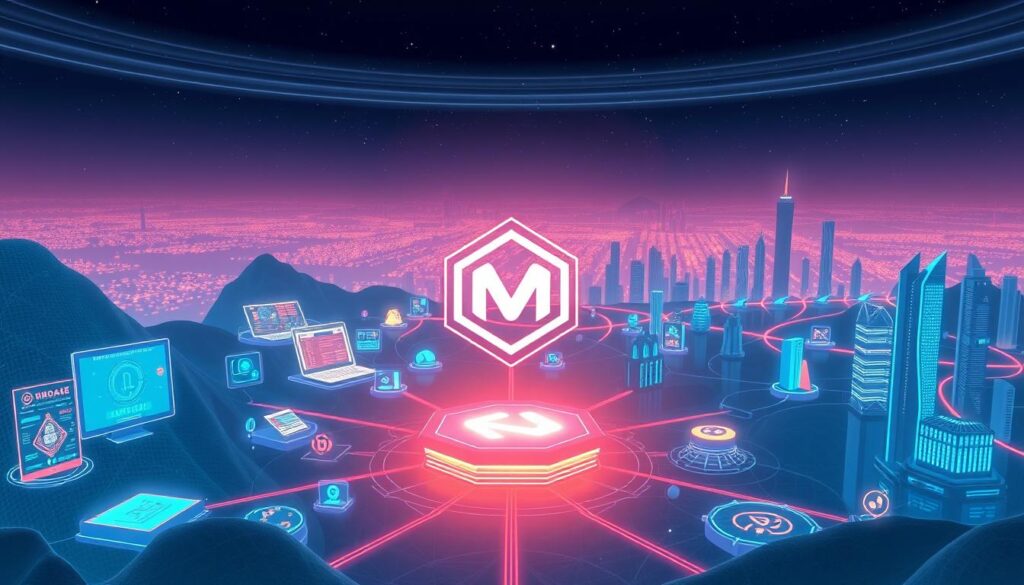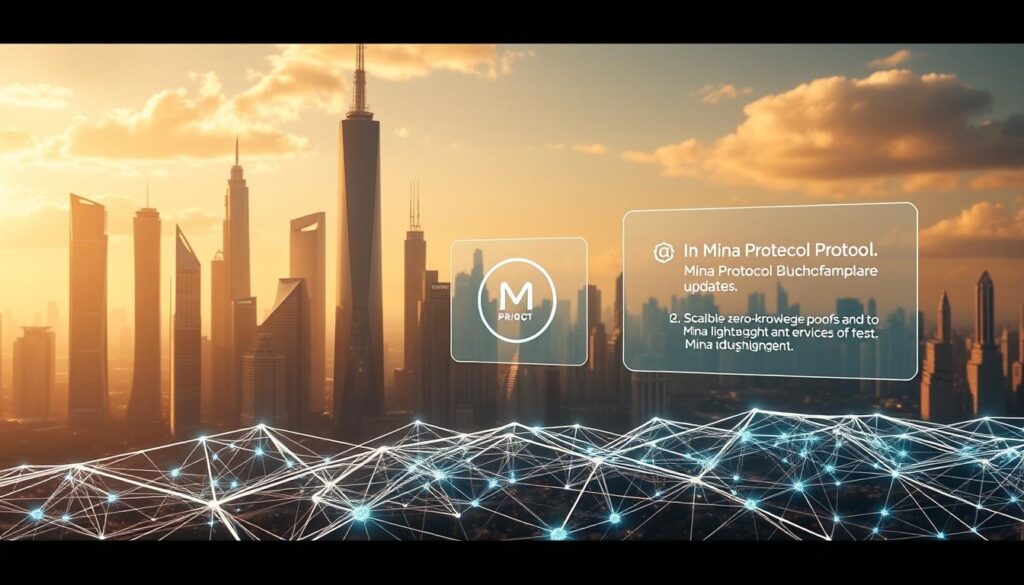Mina Protocol (MINA): The Blockchain Revolution
A blockchain that fits in the palm of your hand? Mina Protocol makes it possible with a size of just 22KB. This is smaller than two tweets. Unlike Bitcoin, which has a huge ledger over 500GB, Mina stores only the current state. It uses cryptographic proofs to skip storing every transaction.
Mina Protocol runs on a special consensus mechanism called Ouroboros Samasika. It uses 99% less energy than Bitcoin’s systems. You can even run full nodes on smartphones or Raspberry Pis. This makes it easy for people all over the world to join Web3.
MINA cryptocurrency holders help keep the network safe by staking their tokens. Privacy-first apps like DeFi and health data platforms also benefit from Mina’s platform.
Key Takeaways
- Mina’s blockchain remains fixed at 22KB despite transaction growth.
- Uses zk-SNARKs to shrink transaction histories into a single Merkle root hash.
- Runs on low-power devices, lowering entry barriers for node operation.
- Reduces energy use by 99% compared to Proof-of-Work blockchains.
- MINA cryptocurrency fuels a privacy-first ecosystem for finance and supply chain.
Understanding Mina Protocol (MINA): The World’s Lightest Blockchain
Mina Protocol changes the game with a blockchain size of just 22 KB. This makes it super easy to use. Let’s dive into its history, design, and major achievements.
The Origin Story of Mina Protocol
In October 2020, Coda Protocol became Mina Protocol. This change showed a new focus on making things easier for users. The team wanted to fix old blockchain problems like being too big and hard to use.
They wanted a world where everyone could use decentralized systems. No need for fancy computers or lots of storage.
Core Philosophy Behind the Lightweight Design
Mina’s main ideas are:
- Accessibility: It’s designed for phones, so anyone can use it.
- Decentralization: It works without special hardware, so more people can join.
- Minimalism: It uses special math to keep things simple and small.
These ideas shape every part of Mina, from how it agrees on things to how it makes money.
The Revolutionary 22kb Blockchain Size
Mina’s big win is its fixed size of 22 KB. That’s as small as two tweets. This is a huge difference from Bitcoin’s massive 300 GB blockchain:
| Blockchain | Size |
|---|---|
| Mina Protocol | 22 KB |
| Bitcoin | 300 GB |
zk-SNARKs make Mina small by proving things without sharing all the details. Every transaction doesn’t add new data. This means even simple devices can help make decisions.
This fits perfectly with Mina’s goal of making blockchain easy for everyone.
How Mina’s Recursive zk-SNARKs Technology Works
Mina blockchain technology uses recursive zk-SNARKs to keep its blockchain at a constant 22KB. Unlike traditional blockchains, which grow endlessly, Mina compresses every transaction into a tiny cryptographic proof. These proofs act like digital fingerprints, confirming validity without exposing private details.
Here’s how it works: each new block links to the previous proof through a process called recursion. Imagine a chain of verified summaries—each proof references the last, ensuring accuracy while staying lightweight. This forms the backbone of Mina’s fixed-size architecture.
- Proofs are 7KB and verify in 200 milliseconds
- Blocks achieve finality in 60 minutes (15 blocks)
- Nodes sync instantly by downloading the latest proof, not the full history
This innovation is a defining Mina Protocol feature. It lets the network scale without sacrificing privacy: even as transactions grow, the blockchain stays minuscule. Developers build apps knowing every user—whether on a smartphone or laptop—can run a full node. For users, this means faster transactions and lower costs compared to networks like Ethereum, whose state size exceeds 600GB and grows weekly.
The same tech powers MINA cryptocurrency’s security. Every proof ensures all transactions are valid, while shielding user data. This blend of privacy and efficiency makes Mina a leader in zero-knowledge blockchains.
Key Features That Set Mina Blockchain Technology Apart
At the heart of Mina Protocol features is a new way to design blockchains. Unlike big blockchains like Bitcoin (348GB) or Ethereum (248GB), Mina is tiny at just 22KB. This small size makes it super scalable and keeps it decentralized.
This is thanks to zero-knowledge proofs and recursive zk-SNARKs. The Mina Protocol ecosystem uses these to make innovation easy for everyone.
Scalability Without Compromising Decentralization
- Fixed blockchain size prevents bloat even during high activity
- 200ms verification time vs. minutes for Bitcoin/Ethereum
- Nodes run on smartphones or Raspberry Pi devices
Privacy-Preserving Smart Contracts
Snapps (SNARK-powered apps) do work off-chain and then check it on-chain. This lets developers make private financial apps. For example, users can show they’re creditworthy without sharing all their financial info.
Mobile-First Accessibility
“Mina’s lightweight architecture makes blockchain accessible to billions of mobile users.”
Full nodes need only 864 bytes of data. This makes it easy to add to web browsers and IoT devices. People in areas with slow internet can join in without special gear.
Next-Gen Security
The Ouroboros Samasika consensus mechanism keeps the network safe with Proof-of-Stake, not mining. zk-SNARKs hide transaction details while checking if they’re right. This combo cuts energy use by 99% compared to Bitcoin’s mining, meeting eco-friendly needs.
The MINA Cryptocurrency: Tokenomics and Utility

The MINA cryptocurrency is key to Mina Protocol’s world. It’s made to help the network grow by rewarding those who help it. With only 3.79 billion tokens available, it’s made to last a long time. Right now, MINA is worth $3.26, with a market cap of $493M. This shows it’s being used for private transactions.
How MINA is given out is very structured. 1.89B tokens were sold first, and 1B are for community grants. The Mina Foundation has 500M for development, and 200M for the core team. This setup helps keep the network fair and supported.
Users can help keep the network safe by staking or participating in consensus. They can choose to delegate to Verifiers or run nodes themselves. This way, they earn rewards based on how much MINA they have. It keeps the network safe without making the blockchain too big.
MINA holders get to vote on changes to the protocol. They decide on things like fees or new partnerships. This makes sure everyone has a say in how the network grows.
The price of MINA can change based on how people use it and new tech. Its ability to work on smartphones for peer-to-peer transactions could help it grow. But, the crypto market can be unpredictable.
Real-World Applications and Use Cases
Thanks to Mina Protocol features like recursive zk-SNARKs and a tiny blockchain size, real-world uses are changing industries. People can use financial services without sharing personal info. This makes privacy-focused solutions possible that old blockchains can’t offer.
- Decentralized Finance (DeFi): Teller Finance uses Mina Protocol for lending platforms. Here, borrowers show they’re creditworthy without sharing personal details. This cuts down fraud and opens up more financial opportunities.
- Identity Verification: Users can prove their age or identity without sharing personal info. For example, someone can show they’re over 18 without giving their birthdate.
- Global Accessibility: Mina Protocol is small enough to run on basic devices. This brings blockchain to areas with little internet and few financial options.
More companies are starting to use Mina Protocol. It works with Copper to help big institutions manage their crypto safely. It also connects with Ethereum and Polygon, making it easier for apps to work across different chains without losing security.
Developers can use zkApp tools to make privacy-focused apps easily. Over 12 million JavaScript developers can now make these apps without needing to know complex cryptography. This makes it easier for new ideas in finance, healthcare, and IoT to start.
New partnerships, like the $1.2M Ethereum Foundation grant, show the growth. Mina Protocol’s light design and strong privacy help solve big problems in blockchain today.
Navigating the Mina Protocol Ecosystem

The Mina Protocol ecosystem grows through new ideas and teamwork. It tackles big issues in finance, privacy, and apps. The Mina Protocol makes systems that are big, fast, and private. The MINA community helps by funding, governing, and coding.
Major Projects Building on Mina
- Teller Finance: A lending platform that focuses on privacy, using Mina’s tech for safe credit checks
- Snapps: Apps like voting systems and data markets use Mina’s small blockchain for easy setup
Strategic Partnerships and Collaborations
Chainlink helps bring real-world data to smart contracts. Academic work boosts privacy tech. These partnerships help Mina meet rules and grow widely. Mina also looks to work with big systems like Ethereum.
Developer Resources and Support
Developers get help from the Mina SDK, supporting JavaScript, Python, and Rust. There are grants for Snapps. A testnet lets developers test apps before they go live. The MINA community offers forums and workshops for learning Mina’s tech.
MINA Price Analysis and Market Performance
Investors keep a close eye on the MINA cryptocurrency due to its price volatility and growth. The Mina token is currently priced at $0.2885. It hit a high of $0.291 and a low of $0.284 in the last 24 hours. Over the past year, its price has dropped by 77.55%, mirroring the crypto market’s trends.
- Historical Performance: MINA’s highest price was $6.49 in 2021. Now, it’s below $0.30. Its lowest price was $0.225 in March 2024.
- Market Metrics: The market cap is $320.5 million, with a 24-hour trading volume of $20 million. It’s available on 41 exchanges, including Binance and Kraken.
- Key Drivers: Price changes are influenced by protocol updates, partnerships, and adoption rates. Regulatory changes and zk-SNARKs innovation also play a role.
Despite a -96% drop from its peak, the MINA price prediction is optimistic. This is because of its lightweight blockchain’s utility. Technical indicators suggest a neutral outlook for the short term. Long-term adoption could lead to a recovery.
Analysts believe ecosystem growth, like new dApps, could spark interest in the Mina token.
Currently, there are 1.11 billion tokens in circulation, with 3.37% annual inflation. Market watchers are keeping an eye on institutional interest and developer activity.
Latest Mina Protocol News and Updates

Keep up with the latest Mina Protocol news and Mina Protocol updates. These updates show the progress toward its 2022–2025 goals.
| Date | Update | Details |
|---|---|---|
| February 18, 2025 | Treasury Protocol Launch | Finalized treasury management tools for transparent budget allocation. |
| September 26, 2024 | Upbit Listing Impact | MINA price surged 1.14% after listing on South Korea’s Upbit exchange. |
| March 1, 2024 | Privacy Blockchain Growth | Privacy coins lost 44.3% market share, but Mina’s focus on privacy zkApps continues to attract developers. |
Recent Mina Protocol news shows progress in its Ouroboros Samisika consensus mechanism. This makes slot leader selection more efficient. The 22KB blockchain is a big plus, making it easy to use on mobile devices.
Upcoming goals include better tools for zkApp developers and more partnerships with DeFi platforms.
For the latest Mina Protocol updates, check their blog. It has news on governance proposals, hackathons, and educational grants. Community efforts are key to growing adoption and making blockchain easier to use.
How to Join and Contribute to the MINA Community
Join the MINA community through three main ways: running nodes, shaping governance, and getting resources. The Mina Protocol ecosystem welcomes all to help build a decentralized future.
becoming a node operator>
Choose your role in securing the Mina Protocol network:
| Type | Role | Requirements |
|---|---|---|
| Verifier | Lightweight node validation | Basic laptop, 2GB RAM |
| Block Producer | Block creation and reward earning | Staked MINA, dedicated hardware |
| Snarker | Zero-knowledge proof generation | GPU-intensive setup |
Validators in the Delegation Program must update nodes within 24 hours of critical issues. They earn 8% of staking rewards when delegated by the Mina Foundation.
participating in governance>
Shape protocol decisions through:
- Staking MINA tokens to vote on proposals
- Proposing changes via the Governance Dashboard
- Reviewing updates in the Q3 2024 Transparency Report
Proposals needing >5% vote support start community debates. Follow updates on the Mina Foundation portal.
community resources and events>
Explore opportunities to grow the Mina Protocol ecosystem:
| Resource | Details |
|---|---|
| Navigators Grants | Up to $50k annually for projects |
| Developer Hub | SDKs and API docs |
| Quarterly Reports | Q3 2024 details available now |
Join hackathons or the Discord server to work with others. The Mina Protocol ecosystem hosts monthly meetups for developers and users.
Conclusion: The Future Outlook for Mina Protocol
Mina Protocol is leading the way in lightweight blockchain tech. Its blockchain is just 22KB, much smaller than Ethereum’s 755GB. This makes Mina fast and easy to use.
Developers can do complex tasks off-chain while keeping things secure. This is a big plus for Mina. The latest updates show progress in making apps like zkBridge and zkOracles. These help apps work better together and use less data.
Experts think MINA’s price might be up and down, but it’s likely to grow in the long run. Features like low fees and smart contracts that protect privacy could attract more users. Mina is working on new solutions to make it even faster and more efficient.
Collaborations with O(1) Labs and the Nil Foundation are boosting Mina’s development. The zkApps Builders Program Cohort 2 is helping to make tools better. This could draw more projects to Mina, which could help its price.
Investors should keep an eye on important updates like new treasury protocols and privacy tools. Even though some people are skeptical, Mina’s unique tech could change how we think about blockchains. Getting the community involved is key to Mina’s success.




